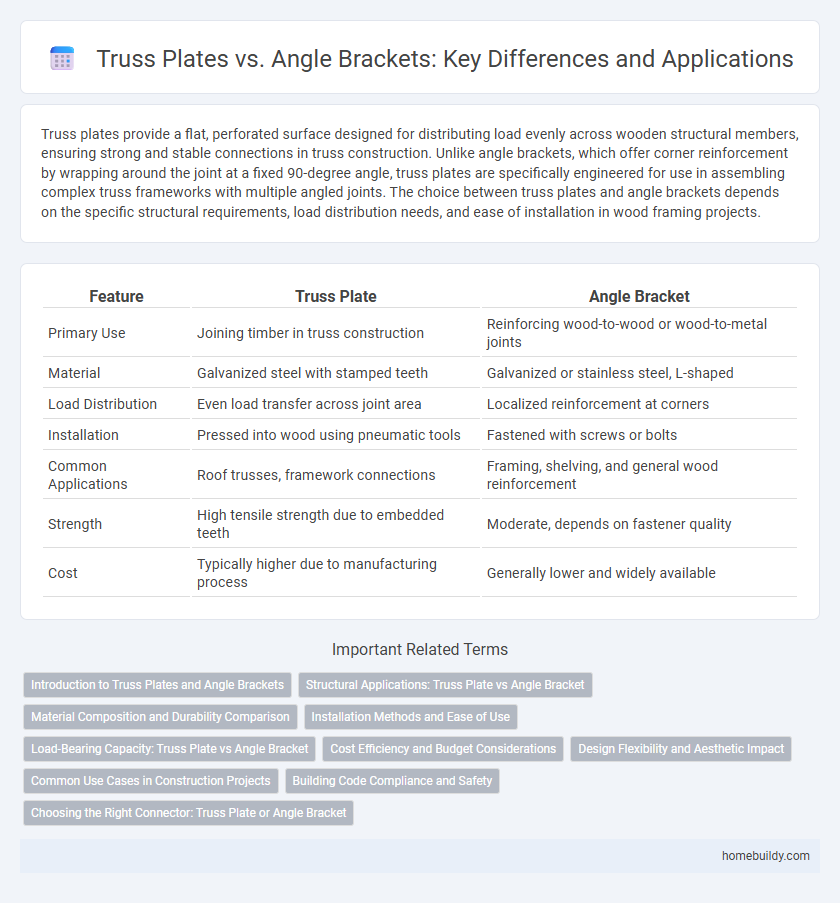Truss plates provide a flat, perforated surface designed for distributing load evenly across wooden structural members, ensuring strong and stable connections in truss construction. Unlike angle brackets, which offer corner reinforcement by wrapping around the joint at a fixed 90-degree angle, truss plates are specifically engineered for use in assembling complex truss frameworks with multiple angled joints. The choice between truss plates and angle brackets depends on the specific structural requirements, load distribution needs, and ease of installation in wood framing projects.
Table of Comparison
| Feature | Truss Plate | Angle Bracket |
|---|---|---|
| Primary Use | Joining timber in truss construction | Reinforcing wood-to-wood or wood-to-metal joints |
| Material | Galvanized steel with stamped teeth | Galvanized or stainless steel, L-shaped |
| Load Distribution | Even load transfer across joint area | Localized reinforcement at corners |
| Installation | Pressed into wood using pneumatic tools | Fastened with screws or bolts |
| Common Applications | Roof trusses, framework connections | Framing, shelving, and general wood reinforcement |
| Strength | High tensile strength due to embedded teeth | Moderate, depends on fastener quality |
| Cost | Typically higher due to manufacturing process | Generally lower and widely available |
Introduction to Truss Plates and Angle Brackets
Truss plates and angle brackets serve essential functions in structural applications, with truss plates designed to connect timber members in roof trusses and distribute loads evenly. Truss plates are typically flat, perforated steel connectors that are pressed into wood, while angle brackets are L-shaped metal fittings used to reinforce joints at right angles. Both components enhance structural stability but differ in form and specific use cases within construction frameworks.
Structural Applications: Truss Plate vs Angle Bracket
Truss plates provide uniform load distribution and enhanced stability for connecting timber joints in roof trusses and heavy framing, making them ideal for high-stress structural applications. Angle brackets are better suited for reinforcing corners and providing supplementary support in lighter framing or retrofit projects where precision bolted connections are necessary. The choice between truss plates and angle brackets depends on load requirements, connection type, and overall structural design parameters.
Material Composition and Durability Comparison
Truss plates are typically made from galvanized steel, providing high corrosion resistance and strength, whereas angle brackets are often manufactured from stainless steel or aluminum alloys, offering varied durability depending on the specific metal grade. The galvanized steel composition of truss plates enhances their longevity in outdoor and high-moisture environments, making them less prone to rust compared to some angle brackets. Durability in truss plates is further improved by their design, distributing load evenly across the joint, whereas angle brackets may experience stress concentration leading to faster wear in comparable conditions.
Installation Methods and Ease of Use
Truss plates are installed by pressing or hammering them into timber joints, offering quick and secure fastening with minimal tools, whereas angle brackets require pre-drilling and screws or bolts for attachment, which can be more time-consuming. The installation of truss plates typically demands less skill and labor, making them more user-friendly for rapid assembly in truss construction. Angle brackets provide flexibility for adjustments but may slow down the process due to the precise aligning and fastening needed.
Load-Bearing Capacity: Truss Plate vs Angle Bracket
Truss plates provide superior load-bearing capacity compared to angle brackets due to their larger surface area that distributes stress evenly across timber joints. Engineered from galvanized steel with multiple teeth, truss plates can resist higher shear forces, making them ideal for heavy structural applications. In contrast, angle brackets typically offer localized reinforcement but are less effective at handling significant loads and may require additional support in high-stress connections.
Cost Efficiency and Budget Considerations
Truss plates offer a cost-efficient solution for connecting timber joints due to their mass production and ease of installation, significantly reducing labor expenses compared to angle brackets. Angle brackets, while providing stronger corner reinforcement, usually involve higher material costs and longer installation times, impacting overall budget constraints. Selecting truss plates can optimize project costs without compromising structural integrity in typical wood framing applications.
Design Flexibility and Aesthetic Impact
Truss plates offer greater design flexibility than angle brackets due to their flat profile and ability to be embedded within timber joints, allowing for cleaner lines and minimized hardware visibility. Their low-profile design enhances the aesthetic impact by maintaining a smooth, uninterrupted surface, whereas angle brackets tend to protrude and create visual bulk. This makes truss plates particularly advantageous in projects prioritizing sleek, modern appearances without compromising structural integrity.
Common Use Cases in Construction Projects
Truss plates are primarily used in wood frame construction to connect timber joints, providing strong, flat, and evenly distributed load-bearing support in roof trusses and floor systems. Angle brackets are versatile metal connectors often used for reinforcing right-angle joints, securing beams, and adding stability in framing, decking, and shelving projects. While truss plates excel in large-scale structural assemblies, angle brackets are favored for smaller, customizable connections and repairs.
Building Code Compliance and Safety
Truss plates offer enhanced building code compliance due to their standardized manufacturing and precise load-bearing specifications, ensuring consistent structural integrity in wood frame construction. Unlike angle brackets, truss plates distribute loads evenly across connected members, reducing stress concentrations and minimizing the risk of joint failure under dynamic loads. Their widespread acceptance in building codes stems from rigorous testing and certification processes, making them a preferred choice for safety-critical applications in residential and commercial structures.
Choosing the Right Connector: Truss Plate or Angle Bracket
Selecting the right connector depends on load distribution and structural design requirements; truss plates provide superior strength for connecting wood members in trusses due to their embedded teeth that ensure a rigid, shear-resistant bond. Angle brackets offer versatility and ease of installation for general framing applications but may not provide the same load-bearing capacity in high-stress truss joints. Engineers often specify truss plates in prefabricated truss systems to optimize joint integrity and building safety.
Truss plate vs Angle bracket Infographic

 homebuildy.com
homebuildy.com